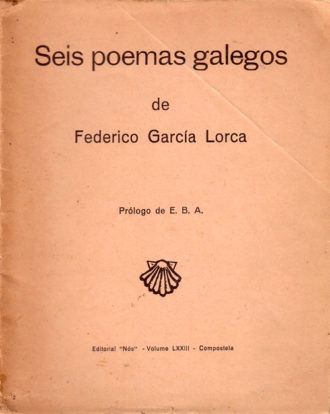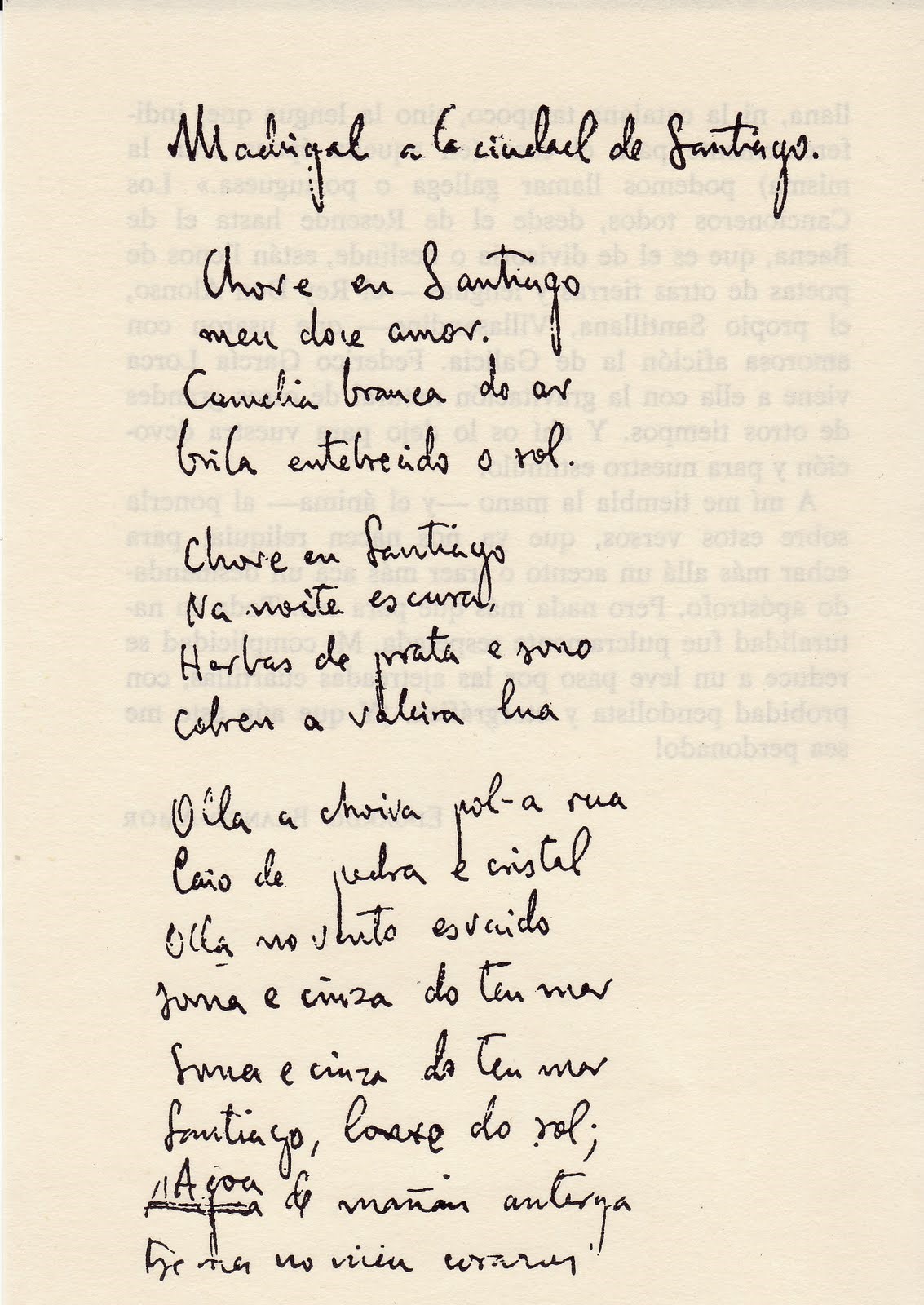
Six Galician poems (Seis poemas gallegos) is a collection of six poems in Galician: Madrigal â cibdá de Santiago, Romanxe de Nosa Señora da Barca, Cantiga do neno da tenda, Noiturnio do adoescente morto, Canzón de cuna para Rosalía Castro, morta and Danza da lúa en Santiago.
All of them mention the influence of the medieval Galician-Portuguese songbooks that Lorca knew so well, and all of them deal with a theme related to Galicia: they are stanzas set in the city of Santiago or that sing to the Galician exiles in Buenos Aires, to one of their virgins or to their main literary figure, Rosalía de Castro.
It was printed on December 27, 1935 (according to the colophon of the first edition), in Santiago de Compostela, at the Nós publishing house, run by Eduardo Blanco-Amor. It seems that Blanco-Amor’s intervention was a bit excessive and that the author did not like it. Blanco-Amor made no mention of Guerra da Cal’s help in his prolog, deleted the dedication to him in Cantiga do nano da tenda and even deleted an epilogue by the author.
The most important modern editions are those of Mario Hernández, in Alianza (together with First Songs), of 1981, and that of Andrew A. Anderson, in Espasa-Calpe (with Divan del Tamarit and Lament for a bullfighter), of 1988. The Nós edition was the basis for the later ones, but given the suspicion of excessive intervention by Blanco-Amor, some editors also checked with the manuscripts.
Most of the texts were composed between 1934 and 1935, except Madrigal for the City of Santiago published in 1932 (Yunque, Lugo, number 6, fall 1932).
Between March and May 1932, Lorca gave a series of speeches throughout the country, mostly under the organization of the Committees for Intellectual Cooperation of the Republic. He was in Vigo (Arquitectura del cante jondo (Deep Song Architecture), on March 27), in Santiago de Compostela (conference-recital on New York, on May 7), and in La Coruña (Architecture…, on May 8)…
It was a great satisfaction for him to visit Galicia again (he had been there in 1916 with his teacher Domínguez Berrueta), he had never forgotten that landscape and had incorporated into his repertoire many Galician songs from the Galician-Portuguese Songbooks of the 12th, 13th and 14th centuries.
His friendship with Ernesto Guerra da Cal was fundamental. When Federico made this trip to Galicia, he was imbued with everything that Ernesto, who lived in Madrid, had told him. On this trip he began to devise his poems in Galician. In fact, fascinated by the cathedral square, and by the fact of knowing that it was once a cemetery, he wrote Danza da lúa en Santiago (Dance of the Moon in Santiago). He gave the manuscript to Carlos Martínez Barbeito (lost).
On his return to Madrid, he read the manuscript to Guerra da Cal and the idea of collaborating to make a book of poems in Galician arose. Therefore, in the summer of 1932 Madrigal â cibdá de Santiagowas published. Returning that summer to Galicia with La Barraca he recited it and left everyone surprised. He submitted it for publication to a magazine and that was when the myth about his ability to conceive poems in Galician began, although the truth is that he had the help of Guerra da Cal. In a couple of years, they were to have another five compositions. And on December 27, 1935, it was printed in Santiago de Compostela.

In a talk he gave in Lugo in November 1932 about María Blanchard, he gave the Madrigal… to the magazine Yunque for publication. From then on it appeared in other Galician magazines and even in Madrid.
The Cantiga do neno da tenda (Shop Boy’s Song), composed after his return from Argentina, reflects the feeling of homesickness of the Galician exiles in that country. It is very well received by them. They will publish it there quickly.
The question is whether they were composed in Galician or not, whether they were later translated by Ernesto Guerra da Cal. Blanco-Amor maintains that they were. Anderson (following the testimony of Martínez Barbeito) emphasizes Guerra da Cal’s help as translator and collaborator, although he does not deny that the poems were originally in Galician. The manuscripts have Guerra da Cal’s handwriting (except Danza da lúa en Santiago (Dance of the Santiago Moon) which is half-written).
Six Galician Poems, prolog by Blanco-Amor.
The great study trip of García Lorca, narrated in 1916 by his companion Luis Mariscal. Includes letters and writings by Federico. Alvarellos Publishing House.